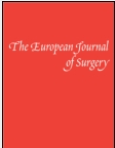Potential mechanisms responsible for zymosan-associated endothelial injury in rats
Abstract
Objective:
To assess alterations in endothelial barrier integrity and potential factors involved in zymosan-associated endothelial injury.
Design:
Experimental study.
Setting:
University hospital, Sweden.
Animals:
42 adult male Sprague-Dawley rats.
Interventions:
One hour before an intraperitoneal injection of paraffin or zymosan (0.25 mg/g body weight), 1.0 ml of a solution of saline, N-acetyl-L-cysteine, dimethyl sulphoxide, indomethacin, verapamil, or allopurinol was given intravenously.
Main outcome measures:
Measurement of tissue water content, tissue intravascular plasma volume, interstitial fluid volume, and extravascular 125I-labelled human serum albumin distribution as well as plasma concentrations of albumin, α1-macroglobulin, α2-antiplasmin, and antithrombin III, 24 hours after the intraperitoneal injection.
Results:
Endothelial permeability significantly increased in abdominal organs and the gastrointestinal tract, and plasma antiplasmin concentrations decreased. Pretreatment with N-acetyl-L-cysteine, dimethyl sulphoxide, or indomethacin protected against zymosan-induced endothelial barrier injury and the decline in protease inhibitors in plasma to varying degrees, while pretreatment with verapamil or allopurinol had a limited effect.
Conclusion:
Oxygen free radicals, prostaglandin, and proteases may have roles in the pathogenesis of zymosan-induced endothelial barrier injuries, implying that several mediators probably are interacting. Copyright © 1999 Taylor and Francis Ltd.




